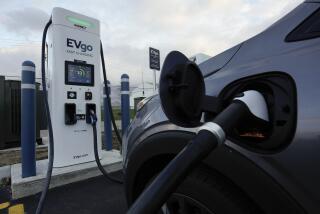Lincoln stays true to form with MKZ Hybrid
Driving eco is often equated with sacrifice — smaller cars with higher price tags that trumpet under-the-hood efficiencies and skimp on in-the-cabin pampering. Efficient as they are, hybrids are the vegans of the automotive world.
FOR THE RECORD:
Auto review: A review of the 2011 Lincoln MKZ hybrid in the Nov. 4 Business section said that only one other luxury sedan hybrid exists: the Lexus HS 250h. There are other luxury sedan hybrids from Lexus, Mercedes-Benz and BMW. —
With its 2011 MKZ Hybrid, Lincoln aims to change that popular perception. A luxury mid-size sedan for drivers who like real butter on their whole-wheat toast, the MKZ Hybrid’s base price is exactly the same as the gas-powered version’s, $35,180.
And it comes with immediate at-the-pump savings. Powered with a 2.5-liter gas-electric drivetrain, the MKZ Hybrid gets 41 miles per gallon in the city, 36 on the highway; the gas-powered MKZ, 18 and 27, respectively.
Despite the long-term savings that come with hybrid driving, a study by J.D. Power & Associates last week said upfront cost is the No. 1 reason customers don’t consider hybrids — or don’t buy one even if they have it on their shopping lists. Hybrids typically come with a 25% to 30% price premium.
Ford is overcoming that sales barrier by spreading the additional cost of its alternative drivetrain technologies throughout its fleet, instead of to individual customers and cars. It’s a smart move.
Doing so enables the company to more quickly cycle through hybrids’ present early-adopter phase and into the mainstream, which is the only way these new technologies will survive. The public has to buy in, or the concepts are dead.
The MKZ Hybrid is a welcome addition to the growing array of hybrids on the market, where only one other luxury sedan exists: the Lexus HS 250h. Most hybrids are defined by their drivetrains and conspicuous in their aerodynamic styling — another reason buyers are turned off by hybrids.
The MKZ Hybrid takes a different tack, pursuing the mainstream with a square-jawed and substantial exterior that doesn’t scream “eco” and instead simply says “Lincoln.”
And the interior follows suit. It is exceptionally quiet, spacious enough for the long and leggy (or merely wide-set) and equipped with all the technological and tactile appointments one would expect in a car at this price point. Its bucket seats are buttery leather and the real-wood veneers on the steering wheel and dashboard glisten in the light.
Both premium surfaces indicate a design mentality that is reaching across the aisle, with hands extended to environmentalists as well as to greenhouse-gas naysayers. While the MKZ’s premium textures will appeal to the pampered, their sourcing will also satisfy the eco-minded. The tanning of the leather is chromium-free, making it easier to recycle; the veneers come from renewable woods.
The only overtly eco aspects of the MKZ hybrid are its sound — turning on the ignition, the car is silent because it starts in electric mode — and the digital dashboard, which, in addition to the traditional fuel gauge and speedometer, features a rainbow of displays.
One of them, in green, shows when the battery is powering the vehicle, and when it’s propelled by gas. Another, shaded blue, indicates when the regenerative brakes are recharging the battery. A third display blossoms flowers to indicate how environmentally, or efficiently, the car is being driven.
These dashboard green-leaf displays are commonplace on hybrids and electric vehicles. They typically sprout stems, stalks or leaves as a sort of graphic shorthand for eco efficiency. For a car with such a meat-and-potatoes pedigree, the apple blossom graphic on the MKZ seems a bit dainty. A tree sprouting greenbacks would be more appropriate, for all the money hybrids save, but perhaps that’s just too crass.
According to the U.S. Department of Energy’s website, FuelEconomy.gov, gassing up the MKZ Hybrid costs $1,083 a year versus $2,013 for the internal combustion version.
Like all hybrids, the MKZ is most efficient at low speeds or in city traffic. It can be driven in pure electric mode up to 47 mph, which helps it achieve its highest mpg. In the week I spent driving the car, I averaged 34 mpg.
Driving this hybrid, the ride quality was smooth. The suspension struck a nice balance between a cloud-like disconnect from the road and sporty stiffness with too much feedback. It was comfortable without being too large to navigate.
Its powertrain is the same second-generation technology Ford introduced with its Fusion last year. The batteries are nickel-metal hydride, which are less powerful than the energy-dense lithium-ion used in new plug-in electrics such as the Nissan Leaf and Chevy Volt.
Still, improvements to the batteries’ chemistry enabled Lincoln to shrink the individual battery cells and make them lighter. The hybrid MKZ weighs only 154 pounds more than the gas-powered version.
The hybrid is propelled with a motor and an engine: an electric 275-volt AC motor that brings the vehicle up to speed and an Atkinson cycle four-cylinder engine that kicks in when the accelerator is pressed aggressively.
The gas-powered MKZ came on the market for the 2006 model year and received a minor face-lift for 2010. Lincoln’s decision to introduce the MKZ Hybrid was prompted by synergy. Customers were asking for it just as Ford was engineering its hybrid Fusion.
Customers wanted it. And the MKZ Hybrid delivers.






